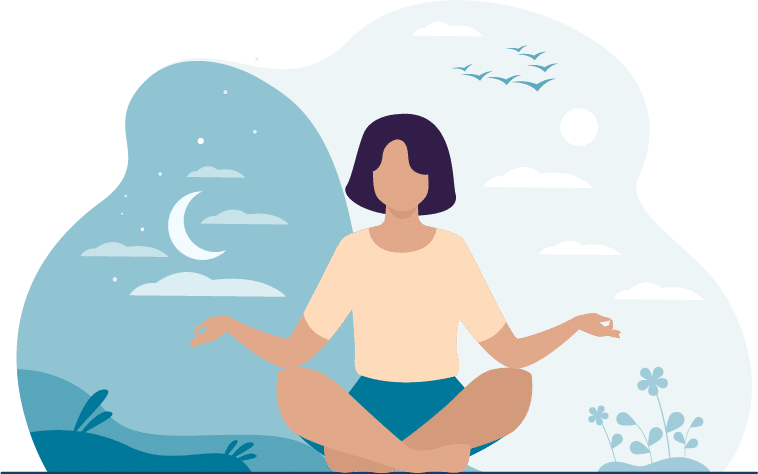
All of the best relaxation techniques in one place for your convenience!
AUTOGENIC TRAINING
Autogenic training uses a combination of breathing techniques, specific verbal stimuli, and mindful meditation to induce your body’s natural relaxation response to counter any negative, stressful, or unwanted mental and physical symptoms.
Six basic techniques are often used in this practice:
- Inducing heaviness. Verbal cues suggest heaviness in the body.
- Inducing warmth. Verbal cues induce feelings of warmth.
- The heart practice. Verbal cues call attention to the heartbeat.
- Breathing practice. Verbal cues focus on breath.
- Abdominal practice. Verbal cues focus on abdominal sensations.
- Head practice. Verbal cues focus on the coolness of the forehead.
The goal you want to achieve at the end of an autogenic training session is a feeling of calmness. As a result, you’ll gain better control over your response to unwanted, negative, and stressful thoughts and feelings.
Before you start, follow these instructions to prepare yourself for relaxation:
Find a quiet place free from distractions.
Lie on the floor or recline in a chair.
Loosen any tight clothing and remove glasses or contacts.
Rest your hands in your lap or on the arms of the chair.
Follow these steps to practice autogenic training:
1. Take a few slow, even breaths
If you have not already, spend a few minutes practicing diaphragmatic breathing. Quietly say to yourself, “I am completely calm”.
2. Focus attention on your arms
Quietly and slowly repeat to yourself six times, “My arms are very heavy”. Then quietly say to yourself, “I am completely calm”.
3. Refocus attention on your arms
Quietly and slowly repeat to yourself six times, “My arms are very warm”. Then quietly say to yourself, “I am completely calm”.
4. Focus attention on your legs
Quietly and slowly repeat to yourself six times, “My legs are very heavy”. Then quietly say to yourself, “I am completely calm”.
5. Refocus attention on your legs
Quietly and slowly repeat to yourself six times, “My legs are very warm”. Then quietly say to yourself, “I am completely calm”.
6. Focus attention on your heartbeat
Quietly and slowly repeat to yourself six times, “My heartbeat is calm and regular”. Then quietly say to yourself, “I am completely calm”.
7. Focus your attention on your breathing
Quietly and slowly repeat to yourself six times, “My breathing is calm and regular”. Then quietly say to yourself, “I am completely calm”.
8. Focus your attention on your abdomen
Quietly and slowly repeat to yourself six times, “My abdomen is very warm”. Then quietly say to yourself, “I am completely calm”.
9. Focus your attention on your forehead
Quietly and slowly repeat to yourself six times, “My forehead is pleasantly cool”. Then quietly say to yourself, “I am completely calm”.
10. Enjoy the feeling of relaxation, warmth, and heaviness
When you are ready, quietly say to yourself, “Arms firm, breathe deeply, eyes open.”
AUTOGENIC TRAINING RESOURCE
- Online guided track
BREATHING TECHNIQUES
Breathing techniques are great tools to have and help with:
Calming anxiety and stress
Relax your mind before bed
Help you fall asleep faster
They’re some of the most convenient relaxation techniques to have in your back pocket because you can do breathing exercises literally anywhere.
4-7-8 Breathing
Inhale through the nose for a count of 4
Hold your breath for a count of 7
Exhale forcefully, making a whoosh sound, for a count of 8
Repeat
Box Breathing
Simply sit or lay down somewhere comfortable and do the following:
Slowly inhale through your nose for the count of 4. Notice your belly pushing out as your lungs fill up with air.
Hold your breath for another count of 4.
Slowly exhale through your mouth for a count of 4.
Once your lungs are empty, hold your breath again for another count of 4!
4x4x4x4 just like a box! And since 4 is the magic number here, we are going to recommend you repeat it 4 times to get started. As you get better you can do it for longer!
Diaphragmatic Breathing
While you’re laying in bed, try placing one hand on the middle of your chest and your other hand on your stomach.
Inhale slowly and deeply through your nose and down towards your stomach. Feel your stomach push up against your hand.
Exhale slowly, tighten your abdominal muscles, and let your stomach fall downwards.
Repeat as many times as needed to feel relaxed, but aim to do 5-10 minutes at a time.
If you’re finding yourself spending up to 20 minutes on this technique and you’re still wide awake, you might want to try another technique.
DIAPHRAGMATIC BREATHING RESOURCE
- Free guided track
GROUNDING TECHNIQUES
Grounding techniques are another super convenient way to relax because they can be done anywhere! In fact, whether you’re in bed trying to fall asleep or you have an upcoming work meeting that’s causing you anxiety, there is a grounding technique for you!
Grounding techniques can:
Reducing stress and anxiety
Calming a racing mind
Relaxing before sleep
Falling asleep quickly
Grounding techniques are coping strategies to help reconnect you with the present. If your racing mind causes you to spiral before sleep, it can cause anxiety to spike, but grounding techniques are a way to bring you back to your focus and calmness.
Likewise, they’re commonly used as action plans for panic attacks, PTSD flashbacks, unwanted vivid memories, overwhelming emotional reactions, or dissociation. In all of these examples, including sleep stress, grounding yourself can separate the cause of your distress from your emotional reaction to it.
333 Rule
Look around you
Name three things you see
Name three things you hear
Lastly, move three of your body parts (such as your ankle, fingers, or arm)
54321 Method
Simply imagine
5 things you can see
4 things you can feel
3 things you can hear
2 things you can smell
1 thing you can taste
Counting backwards from 200
Easy-peasy. This one is pretty straightforward! Just count backward from 200.
Lists
Random: All you have to do is list random objects as they pop into your head, such as “pencil, banana, plant holder, eyelashes, sodapop”
Structured: Just think of any category and then try to name an item that starts with each letter of the alphabet, starting with A.
JOURNALING
Journaling is a very effective and scientifically supported way to reduce stress. In addition to that, it can also be pretty fun and cathartic. It works because it allows your mind to bring closure to the day, express any inner stress and worry, and it is an exercise in mindfulness. Mindfulness simply refers to being present and in the moment. Hense, the more time we spend in the present, the better able we are to connect with the underlying stressors and emotions that can disrupt our sleep.
How to get started:
Ideally, set aside 10 to 20 minutes during your nightly bedtime routine to journal. The purpose of journaling will be to quiet your mind. You can try:
Free association: Writing whatever comes to your mind
To-do lists “to be revisited tomorrow”
Log your day
List the things you’re grateful for
Make up a story – maybe you’ll become a famous author?
JOURANLING RESOURCE
- Learn more about journaling for better sleep
MANTRAS
This ancient and spiritual practice gives your mind something to focus on and creates steadiness from chaotic thought patterns at bedtime. More than that, the meaning behind certain mantras can be enough to soothe your mind before bed.
If you already have a chosen mantra that relaxes you, perfect! If not, here are some commonly used mantra phrases you can try:
Disconnect to reconnect
Inhale the future, exhale the past
Everything I need is within me
I can and I will
I change my thoughts, I change my world
Most mantras are phrases, but some are just single words such as “peace” or “emptiness”. Or you might like the classic “Om” best, which is considered to be the most sacred mantra and is the most commonly used to soothe your mind.
Simply repeat your chosen mantra slowly and with intention. Think about what your mantra means and believe your words, then let them help you sink into a calming state of mind as you drift off to sleep.
MEDITATION
Meditation is amazing for sleep. When you meditate, a variety of physiological changes occur. These changes initiate sleep by influencing specific processes in your body, including:
- increase natural melatonin production
- increase serotonin (precursor of melatonin)
- reduce heart rate
- decrease blood pressure
- activate parts of the brain that control sleep
Your body experiences similar changes in the early stages of sleep. As a result, meditation can promote sleep by initiating these changes.
A lot of sleep problems can be attributed to daily stress and anxieties. In short, meditation helps your body to improve its natural relaxation response. This can reduce nighttime awakenings by improving the control of your autonomic nervous system. For example, a 2015 study, researchers found that mindfulness meditation reduced insomnia symptoms and daytime fatigue.
Body Scan
All you have to do is let your mind focus on each part of your body in a slow progressive meditation:
Start with your toes. Bring your focus to each individual toe, one at a time, then slowly move up to your foot, your heel, your ankle, your shin…take time to focus on each part of your body as you slowly make your way up to your head. Relax each body part as you focus on it.
Guided Meditation
If you’re new to meditation, or even if you’re a pro but you enjoy having someone guide your meditation, there are so many different options for every preference. There are guided meditation tracks with different voices, sounds, and blocks of silence to cater to every unique preference you might have to relax. You may have to try out a few to find your jam, so check our these recommendations:
FREE APPS
PODCAST
Progressive Muscle Relaxation (PMR)
Research has found that this technique can teach your body to fall asleep quicker by increasing your levels of mental quiet and joy. On top of that, it can even reduce chronic pain which could cause you to have trouble falling asleep.
Try this simple exercise yourself by:
Tensing each of your muscle groups, one at a time
Releasing the tension and easing the muscles into a moment of relaxation
PMR RESOURCES
Free guided audio
Yoga Nidra
This ancient Indian technique is a more intense form of mediation. Yoga Nidra is used to take your mind to a place between sleep and wakefulness, and is incredible for relieving stress (it’s even been used to help soldiers recover from PTSD).
During a Yoga Nidra session, the goal is complete relaxation in all of your senses, and some say that just a one-hour session can leave you feeling like you just slept for an entire night.
RESOURCES
- Insight Timer app
- Free MP3 masterclass
- List of free downloads
POSITIVE AFFIRMATIONS
Positive affirmations can be powerful. It’s truly unbelievable what we can train our minds to do with a little encouragement and self-love. While you’re laying in bed, ready for sleep, choose one affirmation that resonates with you and repeat it 10 times. You can keep track by dropping fingers as you say them.
Don’t rush through them and say them with intention. Most importantly, try to really believe the words you’re saying. You can say them out loud or in your head, which makes this technique possible to do anytime, anywhere.
Examples include:
“I release today”
“I’ll let go of today’s anxiety and stress”
“I am safe, I am fulfilled, I am at peace”
“I sleep peacefully knowing that I’ve done all I could for today”
“My muscles are relaxed, my mind is at peace, I am ready for sleep”
✨ VISUALIZATION/VISUAL IMAGERY
Visualization is yet another tool for you to reduce the likelihood of bringing stress and anxiety to bed with you. It trains your mind to allow thoughts to come and go, instead of allowing them to hold your focus and negatively impact your state of mind. Additionally, research has found that practicing visual imagery before bed can improve sleep quality, and it has also been found to reduce pain that can lower your sleep quality.
How to get started:
Visualize yourself sitting on a bench at a train station.
Now, think of each circulating thought as its own train, arriving and departing as they come in and out of your mind.
Keep your awareness on yourself sitting on the bench at the station.
At some point, you may get lost in your thoughts and find yourself riding one of those trains. That’s ok!
As soon as you realize you’re on the train, just imagine the train coming back around to the station and get off. Return back to your bench and continue watching the trains coming in and out of the station.
GUIDED VISUALIZATION
✨ YOGA
Yoga is like if meditation and exercise got married. It’s the best of both worlds, and we already know how amazing meditation and sleep are for sleep on their own!
Yoga has been shown to help benefit all age ranges and improve sleep. From children to the elderly, yoga provides numerous health and sleep benefits. For example, research has shown benefits such as increasing melatonin and reducing nighttime sleep disturbances.






